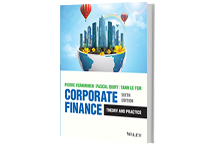Comment, question or quotation of the day
10-01-2026 : Revolut, the price of liquidity and salary infidelity
Revolut is one example among many of start-ups that have managed to capture a significant share of their market, demonstrate the relevance of their business model and continue to be financed by investment funds without going public, despite being profitable ($1.4 billion before tax). To the point that the term "start-up" no longer applies to Revolut.
For a number of investors, this raises the question of the liquidity of their holdings, which can be organised by the investors themselves outside the stock market, and/or by the company itself, particularly when its own employees or former employees are involved.
Before Christmas, Revolut allowed its former employees to sell their shares at 70% of the price of the last capital increase in November 2025 (with a value of £75 billion for 100% of the capital).
This 30% discount for a secondary transaction compared to a primary transaction is frequently observed in the world of start-ups (the real ones, those that are losing money and have not yet established the relevance of their business model). The rationale behind this is that a primary transaction, by providing equity capital to the start-up, gives it additional time to demonstrate the relevance of its business model, which is obviously not possible in a secondary transaction. Therefore, a shareholder in the start-up prefers to contribute funds to the start-up rather than to a co-shareholder who is selling. However, to encourage them to acquire existing shares that do not provide any liquidity to the start-up, the outgoing shareholder will have to agree to a discount. And the observed practice sets this at around 30%.
Part of the November transaction involved shares sold by current employees, but without a discount on the €75 billion valuation. Even though Revolut appears to be considering an IPO, the 30% discount seems thus high for a group that is no longer a start-up. It just goes to show that employee disloyalty comes at a price!
13-12-2025 : The Bitcoin Society (TBSO) IPO, episode 2
Last week, we saw how the practical arrangements for The Bitcoin Society's (TBSO) backdoor IPO, through the acquisition of an already listed shell company, reduced by 95% of its cash and transformed into a limited partnership, were at odds with the project of societal change championed by its founders.
The founders explain that Bitcoin has an advantage over traditional currencies (the euro, the dollar, etc.), namely its limited quantity (21 millions) and the fact that its issuance is independent of governments, protecting its holders against inflation.
The fact that the quantity of bitcoins is ultimately limited to 21 million is not in itself sufficient to protect its holders against inflation, and may expose them to a more serious and pernicious risk, namely deflation.
In a world that has become Bitcoin-based, where the number of bitcoins is fixed indefinitely at 21 millions, the unit price of goods and services, which are increasing in number, will necessarily decrease since they are denominated in a limited number of monetary units that will sooner or later reach their limit of 21 millions of bitcoins. This would be deflation, which historically has rarely ended well. It would be a return to Spain at the turn of the 17th century, when economic activity contracted every time the galleons laden with South American gold and silver failed to arrive in Seville due to pirates or the depletion of mines.
The indefinitely fixed nature of the number of bitcoins does not rule out the risk of inflation if bitcoin were to one day replace current currencies. Indeed, inflation no longer arises, with a few exceptions, from an increase in the amount of physical currency issued, such as assignats during the French Revolution, but from external shocks (energy prices) or excessive growth in bank credit. In the eurozone, for example, the money supply in the sense of M3 is nearly 11 times greater than the amount of coins and banknotes in circulation (€1.6 trillion). In a world that has gone Bitcoin, Bitcoin deposits with banks would still feed Bitcoin loans, the runaway growth of which could still fuel inflation. M3 would not be equal to 21 million BTC.
Buying a fraction of a bitcoin, like my nephews do, means buying a piece of a dream, paying to scare yourself, and starting your financial education by learning first-hand what volatility and loss are. Buying larges amounts of cryptocurrencies, either directly or via TBSO, is as productive for the European economy as buying tulip bulbs from Constantinople in Amsterdam in 1636 in the hope that they would produce black tulips.
It means sterilising savings that could have a social purpose other than supporting bitcoin miners in the United States, China or Russia, or taking the risk of becoming a counterparty to drug traffickers or traffickers of all kinds. Are there not enough opportunities for profitable investments in Europe?


Glossary
The Vernimmen.com glossary provides definitions for a couple of thousands of financial, stock market or economic terms.
This financial dictionary allows beginners to progress in their learning of finance and to experts to cease the precise meaning of a sentence.

Quiz
The Vernimmen.com Quiz offers over 300 questions with answers to progress in your understanding of finance and to test your knowledge.
Questions are sorted by key topics (financial analysis, investment and stock markets, value, financial engineering and financial management).

Survey
We frequently ask our readers to give us their point of view on a specific topic.
You will find here the current survey with the to-date status of answers as well as past polls.

Financial data
Thanks to our partner Infinancial, we can offer on this page financial data on over 16 000 groups around the world.
Updated several times a year, this database offers information sometimes hard to find elsewhere (beta, …)
The Vernimmen.com Letter
Number 169 of December 2025
News : Capital increases without preferential subscription rights of listed companies carried out by ABB
Statistics : Securitisation in Europe and the US
Research : Payment terms, predictive signals of stock market returns
Q&A : What is a coop agreement?
COMMENTS : Comments posted on Facebook



